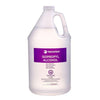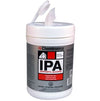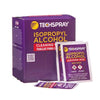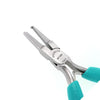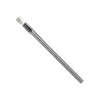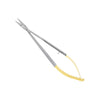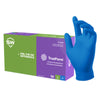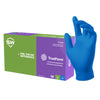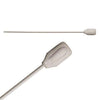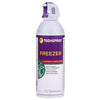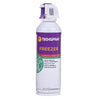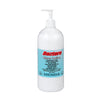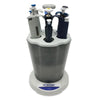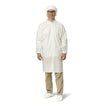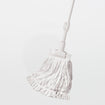- No products in the cart.
Why Choose a Polyester Wipe over a Cellulose Wipe: Which Is Better for Your Purposes?
Aug
24
2020
Cleanroom Wipes can be an essential part of your cleanroom cleaning and maintenance kit, but it's essential to choose the right one for the correct use. A good Cleanroom Wipe should easily remove contamination allowing you to work cleanly and efficiently. But with so many options available, how do you choose the right wipe? This article will help you select the right wipe for the correct application.
 to form a fabric or cloth. Weaving reduces linting by minimizing loose ends and locking stray fibers into the fabric. Woven wipes can be strong, but the quality will depend on the type of thread used and the manufacturing methods.
to form a fabric or cloth. Weaving reduces linting by minimizing loose ends and locking stray fibers into the fabric. Woven wipes can be strong, but the quality will depend on the type of thread used and the manufacturing methods.
The cheapest woven wipes consist of reclaimed fabrics, but beware that these may contain remnants of dyes and other chemicals that can introduce contamination to your work areas. Top-performing woven wipes are produced using synthetic fabrics such as polyester or rayon.
Non-woven wipes are made without weaving. Instead, the fibers are entangled and bound together using solvents or a chemical, mechanical, or heat treatment. Types of non-woven wipes range from cheap single-use disposable paper towels to high performing blends of materials designed to meet specific needs.
So, what is the difference between a polyester and a cellulose wipe?
Monofilament polyester wipes are one of the cleanest wiping materials available. The fabric is woven from smooth, single threads that are less susceptible to linting.
Polyester wipes can be cut in various edge finishes – a knife cut edge is generally the cheapest, but laser or ultrasonic sealing can be used to seal the edges and minimize the risk of linting as well. High-grade wipes are also pre-washed to remove any remaining loose fibers, making these products ideal where the prevention of contamination is critical.
In summary, polyester woven wipes are an excellent choice for high-performance cleaning of oils and greases, especially when avoiding contamination is critical.
It's a non-woven product, consisting of polyester and cellulose fibers which are bound together by hydroentanglement. The bonding process uses fine, high-pressure water jets to entangle the fibers, producing a durable fabric. Since no artificial binders or adhesives are used, this type of wipe is chemically pure and does not leave residues.
The polyester component provides strength and excellent absorption of oils and greases, while the cellulose absorbs aqueous solutions and provides anti-static properties.
A blend of 55% polyester to 45% cellulose is typical, but the proportions can vary depending on requirements: increasing cellulose content gives better absorbance while increasing polyester reduces linting.
For over 40 years, Lab Pro Inc. has been committed to providing polyester and cellulose wipes in California and worldwide. To learn more, visit the biggest Lab Supply showroom in California, or contact us online or at 888-452-2776.
Woven or Non-Woven?
Woven wipes are made from the traditional weaving method by interlacing threads
The cheapest woven wipes consist of reclaimed fabrics, but beware that these may contain remnants of dyes and other chemicals that can introduce contamination to your work areas. Top-performing woven wipes are produced using synthetic fabrics such as polyester or rayon.
Non-woven wipes are made without weaving. Instead, the fibers are entangled and bound together using solvents or a chemical, mechanical, or heat treatment. Types of non-woven wipes range from cheap single-use disposable paper towels to high performing blends of materials designed to meet specific needs.
Polyester or Cellulose?
For high-performance cleaning, the best options are either a woven synthetic fiber such as polyester, or a non-woven blended fiber based on cellulose.So, what is the difference between a polyester and a cellulose wipe?
Woven Polyester Wipe
Polyester is a synthetic fiber made from petroleum, meaning it can naturally absorb solvents like oil, gasoline, and grease. Polyester does not readily absorb water-based solutions, although many pre-saturated options are available to improve sorbent properties.Monofilament polyester wipes are one of the cleanest wiping materials available. The fabric is woven from smooth, single threads that are less susceptible to linting.
Polyester wipes can be cut in various edge finishes – a knife cut edge is generally the cheapest, but laser or ultrasonic sealing can be used to seal the edges and minimize the risk of linting as well. High-grade wipes are also pre-washed to remove any remaining loose fibers, making these products ideal where the prevention of contamination is critical.
Advantages of woven polyester wipes:
- Highly absorbent for oils and greases
- Strong and durable
- Minimal shedding of particles
- Soft and non-abrasive
- Can be sterilized by gamma irradiation
- Disadvantages
- Poor absorbency for aqueous solutions (unless pretreated for specific requirements)
- The highest-grade options are relatively expensive
In summary, polyester woven wipes are an excellent choice for high-performance cleaning of oils and greases, especially when avoiding contamination is critical.
Non-woven Cellulose Wipes
Cellulose wipes provide excellent absorbency for water-based contamination and can be an economical alternative in many situations. However, most non-woven wipes use glues or binders to hold the fibers in place, which can account for up to 30% of the weight of some products. Be aware that cleaning fluids can dissolve many binders, which can result in contamination of the work area.Advantages of non-woven cellulose wipes:
- Economical
- Highly absorbent for water-based solutions
- Biodegradable
- Disadvantages:
- Binders may dissolve leading to contamination
- Subject to linting, especially when wet
- Not as strong as some other options
Polycellulose Wipes – Best of Both Worlds?
A polycellulose wipe contains a blend of materials, combining the absorbency of cellulose with the strength and integrity of polyester.It's a non-woven product, consisting of polyester and cellulose fibers which are bound together by hydroentanglement. The bonding process uses fine, high-pressure water jets to entangle the fibers, producing a durable fabric. Since no artificial binders or adhesives are used, this type of wipe is chemically pure and does not leave residues.
The polyester component provides strength and excellent absorption of oils and greases, while the cellulose absorbs aqueous solutions and provides anti-static properties.
A blend of 55% polyester to 45% cellulose is typical, but the proportions can vary depending on requirements: increasing cellulose content gives better absorbance while increasing polyester reduces linting.
Advantages of non-woven polycellulose wipes:
- Relative low cost
- High absorbency
- Balance of good strength vs. low linting
- Good chemical resistance
- Biodegradable
- Reduces electrostatic discharges
- Can be pretreated with a variety of solvents for specific applications
- Good general-purpose wipe but there may be a better option for specific tasks
In Summary
Cellulose wipes are an economical choice for basic cleaning tasks, but when high-grade performance and elimination of contamination is essential, consider a woven polyester fabric. In many scenarios, a polycellulose wipe can offer an ideal compromise because it combines the cleanliness of a synthetic polyester with cellulose's absorbency.For over 40 years, Lab Pro Inc. has been committed to providing polyester and cellulose wipes in California and worldwide. To learn more, visit the biggest Lab Supply showroom in California, or contact us online or at 888-452-2776.







